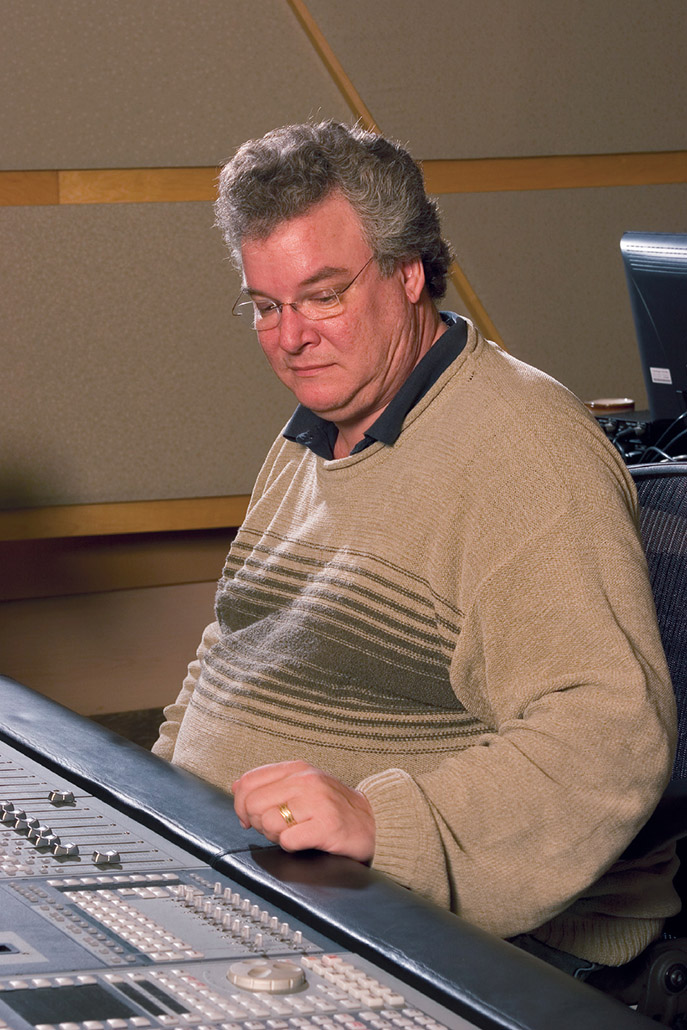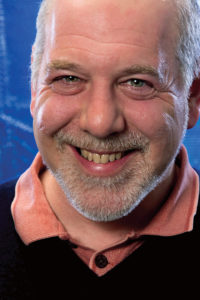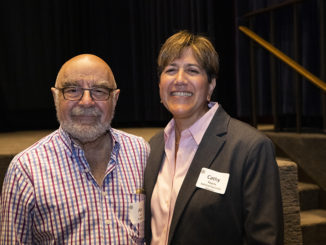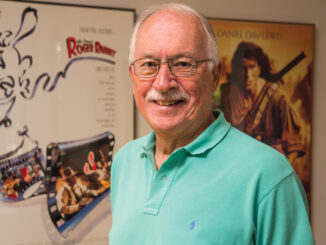
by Kevin Lewis • photos by Kfir Ziv
What distinguishes the Cinderella Man editorial crew, which is headquartered at Soundtrack studios in the Chelsea section of Manhattan, is the tranquility of the soundstage as a scene is projected. When the scene is over, the comments are sparse and polite; notes are given by Anthony “Chic”–always called Chic–Ciccolini III, the supervising sound editor, picture editors Dan Hanley and Mike Hill, or Tom Fleischman, the re-recording mixer. Ciccolini then brings in director Ron Howard, who reviews the scene; notes are relayed, and Howard gives his assessment. At one point, Howard smiles when he singles out his father Rance, an actor in the scene, but every response or statement is politely, so softly delivered that it barely pierces the still air around the group.
There is a legitimate reason for this. Most of this group has spent more of their daily life together than they have with their blood relatives: Hanley since the late 1970s, Hill since the early 1980s, Ciccolini soon after that, and sound effects editor Bobby Chefalas, since Howard’s Gung Ho (1986). ADR supervisor Deborah Wallach, now on her third Howard film, shared the Golden Reel Award given by the Motion Picture Sound Editors (MPSE) with Ciccolini for A Beautiful Mind (2001). Sound effects editor Daniel Pagan joined up with Apollo 13 (1995). Re-recording mixer Fleischman and music editor Bill Bernstein are among the most respected in their fields and have slipped right into the pack on this, their first Howard film. They all demonstrate a synchronization of minds as smooth as the high-tech machinery in front of them.
Though Ciccolini says, “The director sets the tone of the production,” he clearly leads this phase of the post-production process because, as Branka Mrkic-Tana, the dialogue editor and production effects technician, says, “Chic is a great communicator.” He uses the word “choreograph” to describe his role. Mrkic-Tana says, “That’s what Chic does–he choreographs–and yet he has an overall view, and tells you exactly who does what and how.” “And he’s very respectful,” Wallach adds.

The sound editing team uses ProTools to edit the approximately 200 tracks in 5.1 surround sound. Wallach began her career as a picture editor in the documentary field, which is how she knows Ciccolini, who was an editor of documentaries. On Cinderella Man, a boxing film set 70 years ago, Wallach has concentrated on remaining true to the way people spoke then. A major concern has been recreating the 1930s, even down to the sounds in the crowd during fight scenes.
“Audiences are particularly sophisticated today about the manner in which things are mixed,” she says. “Because there is room for so much, there is a place to put those sounds, and you can actually hear them; where before you just put in a general effect. I think that people do have attention to detail in a period piece. You can tell when it feels right. When you put it in the context of the film, then you make a final judgment.” If, as editor Hanley says, film editing is like painting, with each cut creating a moving canvas, then sound editing is the brushstrokes, the shading, the saturation. “It adds another dimension.” Wallach says.
What Wallach accomplishes with ADR is to change the arc of a performance, correct technical problems, change voice and add dialogue. “Certainly, the technical side and performance changes have to be coordinated with the dialogue editors because they have to prepare the tracks,” she says. “There is a lot of communication. Sometimes we work together and replace a syllable or a word, and we have to figure that out before getting to a mix.” And, as she adds, all involved have to share a mutual respect. Mrkic-Tana says, “We do different sections or departments of sound, but we will all talk about and complement each other’s work creatively.”
Howard and his cinematographer shot more than just coverage, and the production track was put together by sound technicians who recorded the crowds (extras on the set), minor characters on the sidelines and audio props, so that Ciccolini’s team had more than the skeletal sound to work with, augment and re-record. Hill and Hanley edited, using the coverage needed, and placed these sounds in the temp mix.

“You knew what was happening at all times,” Wallach says, which not only clarified the sound needs of the fight sequences, but freed both the ADR, the foleys and the sound effects crews to be more creative and inventive. “If you get the picture editing done on this level, it is so much easier for sound people to really be creative,” says Mrkic-Tana. “Just the fact that he has two editors, there is a team already,” she says. “That sets an example that we are teamwork.”
The boxing sequences are the pride of the unit. Everyone recalls with exhilaration the day Ciccolini brought in two boxers from Gleason’s Gym to patiently spar with each other, countless times, in endless variations to replicate the five diverse fights throughout the film. This was necessary, says Chefalas, because, “We couldn’t use any of the punches on the Avid track [which was recorded during shooting]. “Every fight and every boxer has a different sound.” He painstakingly gave each fight its own personality.
“On this film, each fight has a separate character–a different feeling, different crowd reactions, all building to the last fight,” Wallach says. “The sound effects, foley and ADR people have to remember each detail of each fight so as not to repeat anything. “You can’t use something from the last fight in the first one because it’s not going to feel right,” she says. Then, they work together closely to place each effect: the crowd noises, the punches, the atmospheric sounds, etc.
Fleischman’s first film with Howard has been an unusual one for him because the film was locked by the time he worked on it. “It is a rare experience,” he says. “Now with the change in technology in sound and editing, it becomes very easy to make changes. In the old days, when you actually were working with film, and cut it with a blade and taped it back together, it was much more difficult to make changes. You made multiple reels in 35mm tracks that all had to be taken down and put on a synchronizer and conformed to fit the picture. So, in those days, it was much more important that the film be locked editorially before the mix began because that was a very work-intensive experience.”
Digital technology has also made the sound elements much more complex. “In 1980, if a film came in on more than 24 tracks it was a big deal. Now, there can be 240 tracks and it would be fairly normal,” he continues. “The amount of material has increased tenfold, and any time the picture is changed, all of that material has to be adjusted. And then the mix has to be adjusted to fit, so it becomes a big deal.”
“My philosophy on every film is to make it invisible,” says Fleischman, who recently won awards from the Cinema Audio Society (CAS) and the MPSE as re-recording mixer on The Aviator (2004). “What I’m trying to achieve at all times is to avoid making the audience aware that the sound has been manipulated. If I see something that prompts me to think that it should have some kind of a sound, I try to accomplish it with the elements that I have.”

Sometimes, he has to recreate a sound. “Let’s say one the boxers throws a punch, and in my mind, I feel that the crowd should react to that punch–but there’s no crowd reaction there in the elements,” Fleischman relates. “I’ll turn around to Branka or one of the editors and ask them to add something for that particular spot. Then we’ll talk about it, and the director or the editors will either say, ‘That sounds like a good idea,’ or not.”
Since Cinderella Man is a period film, there are many times when lines have to be re-recorded because they sound too modern, but those cases are mainly worked on while the film is still being shot on location or in the ADR sessions. However, in the final mix, there have been a number of instances where lines have been changed because someone feels that they sounded too contemporary. This, however, is extremely tricky because the actors are no longer available to re-dub lines. “My job is to fit everything in, and just make it sound natural,” Fleischman explains. “That’s basically a definition of what I do.”
A modest assessment, but it was an eye–and ear–opener to see Ciccolini and Fleischman work tirelessly over inflections in dialogue scenes to tone down shrillness where it was counterproductive to the scene, or heighten shrillness to make violence believable a few moments later. Inevitably, this changes the nuance of performance, as in a scene when Mae (Renée Zellweger), on the point of hysteria over her fears of her husband’s (Crowe) demise in the ring, forbids him to fight. Fleischman mixed this over and over again, with Ciccolini participating, trying to decide whether to let the shrillness of her voice override the frenzy of the scene or to bring it down. In the end they brought her voice down a few decibels, because, as they agreed, audience sympathy for her would have been lost at a crucial moment in the story. Since the change is approved by Howard, it makes the analogy to a painting even stronger; it is a corrective brushstroke.
Creating the environment in a period film, was a welcome challenge for Pagan, who re-thinks his modern world and creates a world “outside of what I am seeing,” listening for distant police whistles, dogs barking, sounds which were more distinct in years past. “I try to create my own world within their world,” he explains. He and Ciccolini have worked together so long that, “We are on the same wavelength.” Ciccolini concentrates on the boxing sequences and Pagan handles what he calls “all the specifics beyond that–anything other than a background.” He avoids effects under dialogue, but admits to placing an effect at the tail end of a word. “If it’s a busy street, like Broadway, you have a heavier sound than you would in the meat-packing district,” he says. “I’ll work with Chefalas because he’ll get everything set to a level. Ron likes to do the dialogue pre-mix and the effects pre-mix at the same time. That way, it is in the final mix a lot quicker.”
Music editor Bernstein, who won the Golden Reel Award from the MPSE for Finding Nemo (2003) and American Beauty (1999), has worked with Cinderella Man’s composer Thomas Newman since 1989. Newman, who has composed music for Howard since Gung Ho, is a favorite of Ciccolini also because the composer appreciates how his music has to fit organically in a movie. This is Bernstein’s first time working on a Howard film, however. He works with both Howard and Newman, spotting the music and its placement within each sequence and transition of the film.
“Audiences are particularly sophisticated today about the manner in which things are mixed,” – Deborah Wallach
“By the time I first saw the film, Hanley and Hill had already put temp music in,” Bernstein says. And he was impressed, “because it really informed how they put the scenes together.” Because of that step, which is easier now because of digital technology, Howard and Newman “had a pretty good idea where they wanted music, and more or less what the tone was supposed to be.”
Temp music is replaced when the score is composed, says Bernstein, because it is source music rather than original. “It happens rarely that the director says, ‘Well, we’re so in love with that piece, we want to try to license it,’” the music editor says, because, “It’s a hassle trying to find the rights to use it, and then it’s terribly insulting to your poor composer.” Period music from a radio or a car, is another question. Howard makes extensive use of period artifacts, including movie posters on street buildings.
“I’ve become the confidant of Newman,” Bernstein confesses. “We kind of work together as he writes, but I am also responsible for checking all the source music,” which can consist of the pre-recorded music, any alternate music choices and scene notes. During recording sessions, besides taking notes and monitoring the picture updates and the music synchronization, Bernstein is the liaison among the picture department, Newman and Howard.
Howard met with Newman in Los Angeles on several occasions to listen to demo recordings created by Newman on synthesizer. “They were very crucial meetings, where we really decided on this piece, not that piece; we can use that here and here, a little more wistful at the ending,” Bernstein explains. “I’m sort of the continuity between those meetings and post-production, when I present the finished product to Ron.”
Creating the environment in a period film, was a welcome challenge for Daniel Pagan, who re-thinks his modern world and creates a world outside of what he’s seeing.
There are also cases where Howard has suggested alternatives. Bernstein is impressed with the director’s decision-making and trust in whom he hires. “Instead of micromanaging and second-guessing all the time, he just has a few little comments and a lot of encouragement,” the music editor attests. “He’s a good leader. Directors need to be good leaders and few are, it turns out. I would follow him into battle. Some directors will willy-nilly cut a scene in half. It’s already been scored, and they have no knowledge of what the repercussions are.” A director of that type saps the creative people, Bernstein believes.
Bernstein processes the music using ProTools, working with the composer’s changes and suggestions, but, as he admits, “Sometimes there is only so much you can do, so much I have control over, either in processing or editing, or in replacing cues with other cues.” Sometimes the music has to be remixed, “meaning it’s there in what they recorded but certain elements have to go away, or certain elements have to be added, or the balance overall has to be shifted in a way that I can’t do,” he adds. The director usually goes to the scoring session when it is being recorded with the orchestra, and Bernstein hopes that at that time the director determines if “it’s too big, you’ve really got to leave the brass out,” or other suggestions to the composer.
The score for Cinderella Man “has a big dynamic range,” he says. “It’s a very small intimate story about this family, and this couple, Jim and Mae Braddock, and they have to send their children away because it’s during the Depression; he’s broke, he can’t get a job, he breaks his arm fighting,” Bernstein explains. “There are very small interior cues, there is some piano and strings, and then at the end there is this big fight scene, where he is winning these fights that he never should have won. There are such huge triumphant horns, and a full orchestra just blaring; triumphant, lovely. There are 50 minutes of music, which is about average for a movie of this length, and there are long portions throughout that don’t have any music at all–and you don’t miss it.”
Ciccolini, whose father was is a retired film editor and whose mother worked with emulsions, is passionate on the subject of projection and sound, a sentiment echoed by Wallach and Mrkic-Tana. “For the amount of months that we work on the soundtrack, it’s amazing to me how lax the theatres have become,” he says. More of his sound editing may be experienced on a DVD release than the theatrical showing, he points out.
“All too often I’ve gone to theaters to see films that I’ve worked on and have been completely blown away by how terrible the sound is,” he complains. “I have literally had words with the managers.” The managers tell him that they don’t make money on the movie but on the concession stand, which frustrates Ciccolini even more.
Apparently, the nuances of 5.1 surround sound are not appreciated by everyone.





